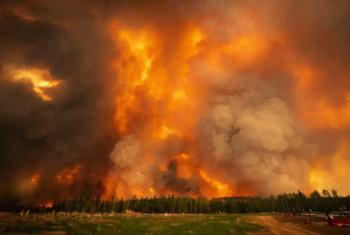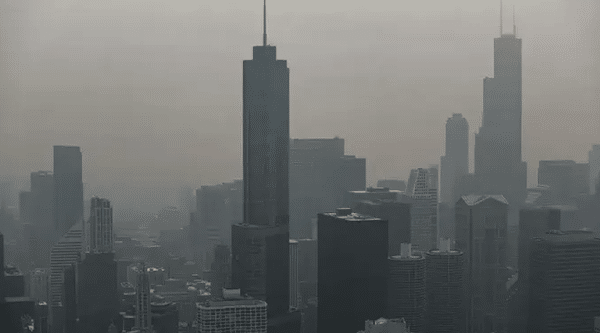The beginning of July saw the hottest days on record globally. Daily heat records were set on July 3, 4, 5, and 6. Each day topped the previous day’s record, according to data from the University of Maine’s Climate Reanalyzer. The temperatures on these days are the hottest since record-keeping began.
“This record is the visible part of a huge amount of silent and often unnoticed suffering and dying of people and ecosystems,” says Friederike Otto, a climate scientist at Imperial College London.
We live in a dramatically different world to just a few years ago.
At the same time, many parts of the U.S. are being blanketed with some of the worst air quality recorded, caused by particularly severe wildfire activity in Canada. It is likely that smoke will continue its penetrations, as Canada’s fire season is expected to run until at least October.
Canada is currently experiencing its worst wildfire season on record. As of June 29, 2023, over 3,000 wildfires in Canada have burned over 19 million acres of land. This is more than ten times the average number of fires and acreage burned during this time of year.
The fires have been particularly destructive in Quebec, where over 2 million acres have burned. The smoke from the fires has made air in parts of Canada and the U.S. among the most polluted in the world.
On June 29, Chicago and Washington, D.C., had the worst air quality in the world, while Detroit and Minneapolis were in the top 10, according to IQAir.com.
The smoke from the Canadian wildfires has laid a thick blanket over parts of the Midwestern and Eastern U.S. Over 120 million people, or more than a third of the U.S. population, were under air quality alerts. It’s a major health hazard. The particulate matter, fine particles that can be breathed deeply into the lungs, poses considerable health risks.
Studies have linked wildfire smoke with higher rates of heart attacks, strokes, and cardiac arrests, increases in emergency room visits for respiratory conditions, and weakened immune defenses. The effects of exposure can persist for years.
In addition, prolonged exposure to elevated ozone levels is also dangerous and considered to be a cause of asthma.
Because of the shroud of smoke, solar power generation in parts of the Eastern U.S. plummeted by more than 50%. According to the region’s grid operator, solar farms powering New England were producing 56% less energy at times of peak demand compared with the week before.
Reports in the big business media generally mention weather conditions and climate change as factors, including:
- Drought: Much of Canada is experiencing a severe drought, which has dried out vegetation and made it more susceptible to fire.
- Warm temperatures: The average temperature in Canada has been above normal this year, contributing to the severity of the fires.
- Wind: Strong winds have helped to spread the fires and make them more difficult to control.
- Climate change: Climate change makes wildfires more likely and severe in Canada. As the planet warms, the risk of drought and extreme weather increases, creating the perfect conditions for wildfires to start and spread.
Nothing to argue with there. But it leaves out another key factor: the industrialization of Canada’s forests.
A reference to this can be found in a careful reading of a New York Times report, “How Could This Happen?: Canadian Fires Burning Where They Rarely Have Before”:
A combination of factors, fire officials said, laid the groundwork for the spread of wildfires in the Chibougamau area … Built on mining and the logging industry, Chibougamau is one of the few bold names on maps of Quebec’s vast, thinly populated northern regions.

Alberta is the province with the most wildfires this year, including this blaze west of Fox Creek.
Canada is now mostly tree plantations and “managed forest,” which is more like a mono-crop farm than a forest, and much more prone to catastrophic burns. Clearcut logging and mono-crop replanting make wildfires worse.
A report, “Are the Canadian wildfires really ‘natural’ disasters” by Lambert Strether, documents this.
First, from the Natural Resources Defense Council:
The logging industry relies heavily on replanting efforts that create tree stands that are less biologically and structurally diverse and less resilient to future disturbances like extreme weather and climate change than the trees that have been removed. This exacerbates clearcutting impacts because even when these forests regrow, many have been turned into monoculture tree plantations that do not have the same ecological health as intact, multispecies forest ecosystems.
One 2012 study argued that “the widespread application of even-aged, single species management at all scales of boreal forest management interferes with fundamental ecological processes that maintain ecosystem integrity in boreal forests.”
In the report “Forest Herbicides, Monocultures Drive Wildfires, Harm Wild Species,” the Edmonton Journal says:
Forest companies using herbicides and mechanical removal methods to eradicate aspen from the spruce and pine crops they want to harvest are depriving moose of a winter food source and making wildfires more likely in Alberta forests, the Edmonton Journal reports.
The clumps and colonies of aspen that grow around Edmonton and northern Alberta “are less likely to burn than spruce or pine and cool the forest so well that, when fully-leafed out, wildland firefighters flee to a stand of aspen if the fire unexpectedly shifts,” the Journal explains.
But “forestry companies consider aspen a weed when growing conifers, spruce or pine. So roughly 30,000 hectares a year of forest are sprayed with glyphosate, the active ingredient in RoundUp. That’s roughly half the size of Edmonton, or 40% of the 80,000 hectares of forest harvested annually” across the province.
By killing off all the broad-leafed species, the companies create a monoculture, “making a coniferous tree plantation instead of a forest,” the paper adds.
The Halifax, Nova Scotia, Examiner reported in “The NS wildfires are not ‘natural’ disasters: climate change, forest management, and human folly are all to blame”:
“What’s really changed is the condition of our forest,” [professional forester Wade] Prest tells me. “It’s no longer diverse.
“Our original forest was probably mostly mixed. It tended towards a softwood mix in some areas, and to hardwood mix in others,” Prest explains. Prior to European settlement, he says Wabanaki-Acadian forests would have good canopy coverage, and underneath the canopy, it would be generally damp most of the time, without a lot of sunlight getting through to the forest floor.
“And that in itself would be what would stop the fires from either starting or being widespread,” Prest says. “Certainly, the forest has changed.
“I’ve always been critical of industrial forestry practices, and have vigorously promoted the natural Acadian forest as a model for ecological, social, and economic sustainability for Nova Scotia,” Prest says.
The Halifax Examiner report adds:
One of the greatest defenses that we have against fire risk is diversity… not just of species composition but also age and physical attributes. [Mike Lancaster, coordinator of the Healthy Forest Coalition in Nova Scotia] notes that after World War II and the Vietnam War, there was an explosion in the development of herbicides that were used to kill off deciduous species and manage forests for softwood species industry was looking for.
“It is widely known that conifer forests present a greater forest fire risk than those which are deciduous dominant,” Lancaster says. Because the forestry industry in Nova Scotia has historically been geared to favor coniferous species, in his view, “That translates as an increased forest fire hazard.”
Finally, author Peter Gelderloos in Quebec says on a Twitter thread:
The fires in Quebec are raging in tree plantations that get counted as carbon offsets… Tree plantations are part of the industrial system of extraction and production. A form of mono-crop farming, they are the basis for the profits of the logging industry, which is more in demand as green products proliferate… Tree plantations are also advantageous because they are fully integrated with the mining industry, using some of the same extraction infrastructure and helping cover up part of the sacrifice zones mining leaves behind…
Most urban people and settlers do not know what a forest is. They see trees and think it is a forest.
Governments use the term “forest” without distinguishing between a forest ecosystem and a tree plantation. When I talk about a forest, I’m talking about a robust ecosystem. Granted, non-forests exist on a continuum from mono-crop tree plantations planted in rows to post-clearcut regrowth that is managed and commercially harvested.
The forest fires in Quebec and Ontario originate disproportionately in “managed forest,” which are on the continuum of tree plantations.

